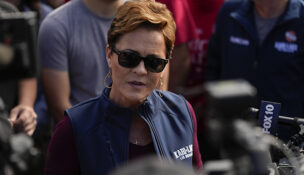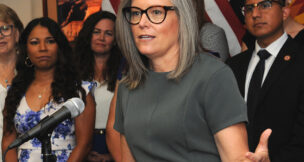Hobbs unveils vision for flying cars and 3D travel in Arizona
Howard Fischer, Capitol Media Services//November 13, 2024//[read_meter]
Hobbs unveils vision for flying cars and 3D travel in Arizona
Howard Fischer, Capitol Media Services//November 13, 2024//[read_meter]
For those who think traffic is bad and many Arizonans don’t know how to drive, here’s a thought to consider: Flying cars.
But Gov. Katie Hobbs is taking steps to have the Arizona Commerce Authority expand its role into looking at what it would take for the state to make such products available here. And that covers everything from being a place where the technology can be developed to how the state would license what are known as “roadworthy aircraft.”
And that’s just step one. She also is looking farther down the road at making things like flying taxis that can take off and land everywhere available in Arizona on a commercial basis.
To get there, the governor announced Wednesday she is revamping an existing agency division that now deals with things like autonomous driving vehicles into the Institute for Advanced Mobility, emphasizing the future is now about three-dimensional travel. And that, said Hobbs, could form the basis for making these technologies available here.
Lawmakers already have tried to take the first baby steps.
Sen. David Farnsworth, R-Mesa, introduced legislation earlier this year to make sure that when what some call “roadable aircraft” are available, the state will be ready to register them.
He proposed creating a one-stop process where the owners of these vehicles could get the necessary licenses both to drive on the interstate and soar at 12,000 feet. Farnsworth’s plan would allow them to be registered as a motorcycle – they have only three wheels – though motorists would not need a motorcycle license or to wear a helmet, as the cabin is enclosed.
And because they would be operated on Arizona roads, they also would need an Arizona license plate.
Only thing is, these vehicles need a length of runway. And nothing in what Farnsworth had proposed would allow them to take off or land on a street or highway, leaving airports as the only option.
But rather than having to leave your roadable aircraft at the airport and call an Uber, this would allow owners arriving at their location to simply fold up the wings and drive to their destination.
Still, hurdles remain.
One is that what is being advertised for sale now and delivery later actually is classified by the Federal Aviation Administration as “experimental aircraft,” which are not certified.
So, there’s no going to your local dealer to pick one up. Instead, under federal law, experimental aircraft can be entirely self-built.
Samson Sky is working to qualify under those regulations, with its proposed Switchblade vehicle with folding wings sold as a kit. That meets the FAA requirement that more than 50% of the assembly be done by the owner, though the company offers a “builder assist” program to allow buyers to complete their portion of the assembly using computer-driven machines to make their parts.
And anything build as an experimental aircraft needs 40 hours of flight testing by the owner in a limited airspace before he or she can take off for anywhere else.
For the moment, though, all that remains academic.
Samson CEO Sam Bousfield, who lobbied for the Farnsworth bill to clear the way for eventual sale of the kits for his vehicles in Arizona, said production and delivery will start in about two years, with would-be owners able to put down a non-refundable deposit of $500. So far, he said, more than 60 Arizonans have a place in line for the “Switchblade” vehicle.
But Marisa Walker, executive director of what the governor is revamping as the Institute of ADVANCED Mobility, said she doesn’t see these one-occupant, self-built vehicles as the future of technology. Instead, she said it is just an interim step in what is coming.
It starts with new rules from the FAA, which could pave the way for flying taxis.
In essence, the federal agency is now going to allow “powered-lift aircraft.”
That means vertical take-off and landing, referred to as VTOL. And it also means there won’t be a need to drive your experimental vehicle to an airport before using it in the air – and no need for state regulation as anything that occurs above ground is solely the purview of the feds.
Think of the scene at the end of Back to the Future where Doc Brown tells Marty McFly, “Where we’re going, we don’t need roads.”
Much of what’s involved here, said Walker, is developing the technology. But she said the decision by Hobbs to expand the role of the state Department of Commerce is designed to have Arizona play a role in all that, including providing places where that can be tested.
What she envisions next is the ability to call an air taxi as easily as summoning an Uber.
As passenger-carrying vehicles, they would have to be FAA-certified. And the federal agency also has to craft the rules for air traffic and who can use what airspace.
Still, there is a role for state regulation. After all, no one wants one of these air taxis just dropping in at a busy downtown intersection.
So, just like buses not making random stops anywhere, this new technology could mean creating certain “stops” where these vehicles are available.
“That’s trying to understand not only what our assets are, where are the best locations for these vehicles to go from Point A to Point B at the appropriate time but working closely with the local municipalities to have the capability of understanding their own land use and where they best see the need for mobility options for their particular communities,” Walker said.
She figures the first places likely to get such point-to-point transport are the major markets of New York and Los Angeles.
“Phoenix and Mesa are not too far behind,” Walker said.
Farnsworth said he is unsure whether he will pursue his original legislation when lawmakers reconvene in January. And he agreed with Walker that where the concept is now headed – and where the focus should be – is less about self-built flying cars and more about vertical take-off and landing.
Arizona has been on the edge of such technology being unveiled.
She pointed out that Amazon just got federal permission to use drones to deliver items of five pounds or less to customers within a few miles of its Tolleson distribution facility, with a one-hour turnaround on orders.
The only other place that Amazon has gotten such permission is College Park, Tx., where the company is now delivering prescription medications.

















